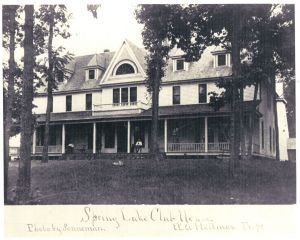By Jared Olar
Library Assistant
Last week we learned more of the ephemeral history of the “aborted” town of Spring Garden that was platted and surveyed in Spring Lake Township in 1856. This week we will delve into the history of the lost town or village of Spring Lake, which once existed on the shores of Spring Lake in southwestern Tazewell County, down on the Tazewell-Mason county line.
We briefly told of the village of Spring Lake during our series on the unincorporated communities of Tazewell County two years ago. As I wrote at that time, in a “From the History Room” post that is dated 25 July 2019:
“The first community to be established along Spring Lake was the eponymously named unincorporated town of Spring Lake, which once existed on land atop a bluff above the southernmost tip of the lake, along the Tazewell-Mason county line.
“The late Fred Soady, in his 1979 ‘Preliminary Master List of Settlements in Tazewell County, Illinois,’ describes the erstwhile town of Spring Lake as the ‘southern part of Sand Prairie settlement along Illinois River.’ According to Soady, this settlement had its own post office from 1856 to 1864. In addition, Charles C. Chapman’s 1879 ‘History of Tazewell County,’ page 637, says, ‘The town of Spring Lake, which is located on sec. 16, 22 north, 7 west, was laid out May 15, 1862, by Thomas G. Conant.’
“The town of Spring Lake appears on old county plat maps of Spring Lake Township in 1864 and 1873, and a plat of the town itself was published in the 1873 ‘Atlas Map of Tazewell County,’ page 132. However, the town failed not long after the publication of Chapman’s Tazewell County history – the map of Spring Lake Township in the 1891 ‘Plat Book of Tazewell County’ shows no trace of Spring Lake town. In that atlas, the land that had once been the town is shown as the property of the Pekin & Spring Lake Hunting & Fishing Club. Today the former site of Spring Lake town has been reclaimed by the forest – the only thing there now is a short winding stretch of State Park Road.”

Further information on the town of Spring Lake is available from Ken Lacey of the Manito Historical Society, who (as I mentioned last week) told of Spring Lake’s history in a post of 10 July 2019 to the Society’s Facebook page. In his account of the town of Spring Lake, Lacey wrote:
“Located along a line from Havana to Pekin, Spring Lake and Spring Garden were in hopeful anticipation that the proposed Illinois River Railroad would be routed nearby. The railroad surveyor instead routed the railroad near land in which he had a personal interest. This change ended the hopes of the existing village of Spring Lake and destroyed Spring Garden’s hopes of a future. . . .
“Informally laid out as early as 1849, Spring Lake officially was platted in 1852. The village added the Lily Addition which was platted in 1858. Spring Lake was said to have two doctors, four stores, a blacksmith shop, a hotel, and a population of over 125. At the top of the hill was located a grain dealer. When grain needed to be shipped it was bagged and would be tossed on a ‘slide’ which let the bag slide down the hill to the loading dock. Often neighborhood boys jumped on the bags and rode them like a toboggan. This action gave the place the name of ‘Toboggan Hill.’
“A saloon was built on the Tazewell/Mason county line allowing its occupants to walk to one side or the other to avoid jurisdiction of Law officers. The last listed business was in 1868.
“The 1902 ‘Pioneers of Menard and Mason Counties’ said of Spring Lake village, ‘Spring Lake is now a desolate waste; only a few cellars that time has failed to fill with drifting land marks. The places so busy with trade and traffic are now relegated to oblivion.’
“In 1852 Spring Lake was a vibrant growing village which had the possibility of having both a railroad and a steamboat port creating what seemed to be a bright future for the residents of the village. In 1902 just 50 years later the village was being called a ‘desolate waste,’ ‘relegated to oblivion,’ mentioned only as memory in history books.”
It should be noted that there is a discrepancy between Lacey’s date for the original platting of Spring Lake (1852) and the date mentioned in Chapman’s 1879 history of Tazewell County (1862). It is Chapman’s book that is in error – a simple typo of a “6” for the correct “5.”
The complete title of the 1902 book to which Lacey refers above is “Pioneers of Menard and Mason Counties; made up of personal reminiscences of an early life in Menard County, which were gathered in a Salem life from 1830 to 1840, and a Petersburg life from 1840 to 1850; including personal reminiscences of Abraham Lincoln and Peter Cartright.” The author, T. G. Onstot of Forest City, gives a personal recollection of the lost town of Spring Lake on pages 379-383 of his book, which is available online in a digital format.









